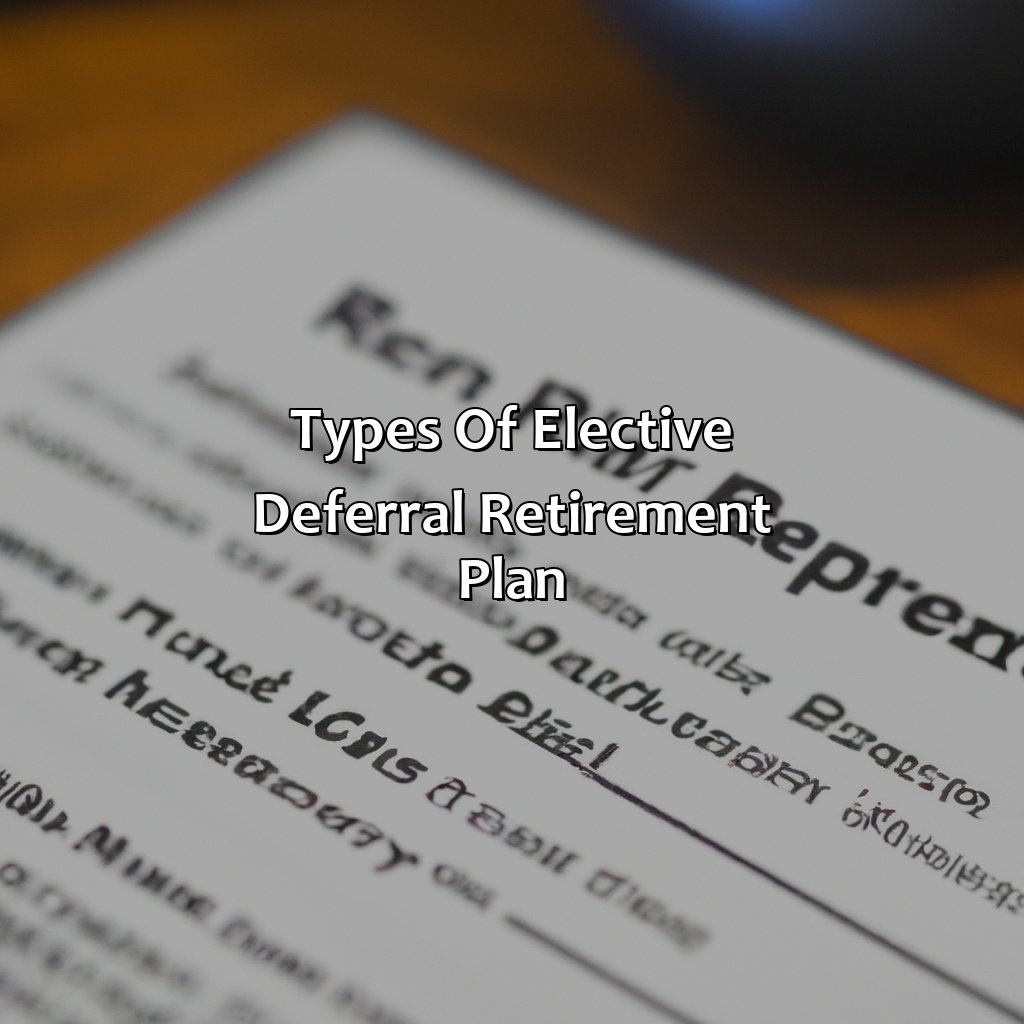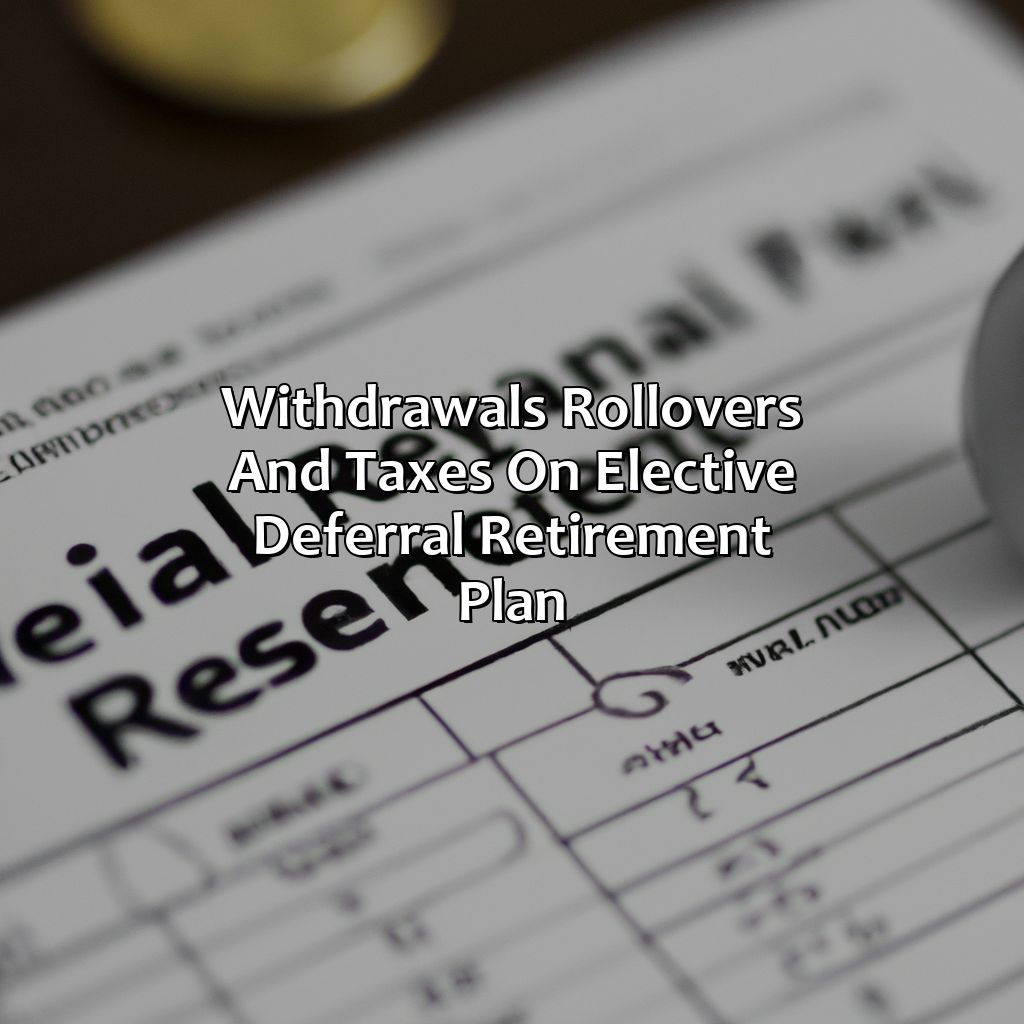What Is Elective Deferral Retirement Plan?
Key Takeaway:
- An Elective Deferral Retirement Plan is a type of retirement plan that allows employees to choose to set aside a portion of their salary on a pre-tax basis to save for retirement. This can be an effective way to save for retirement while reducing tax liability.
- Benefits of an Elective Deferral Retirement Plan include potential employer matching contributions, tax-deferred growth, and the ability to save significantly more for retirement than with traditional savings methods.
- Eligibility for an Elective Deferral Retirement Plan varies based on the employer and employee, with qualifying employers including for-profit and non-profit organizations, while qualifying employees typically work at least 1,000 hours in a year and have met age requirements.
Are you wondering if an elective deferral retirement plan is the right choice for you? You can gain financial security and peace of mind by understanding what it is and the benefits it provides. This article gives you an overview of what an elective deferral retirement plan is and how it works.
Overview of Elective Deferral Retirement Plan
An Elective Deferral Retirement Plan is a flexible option where employees can choose to defer a portion of their salary into a tax-advantaged retirement account. This allows for savings to accumulate over time, providing a reliable source of income during retirement. Employers may offer different plan options, including 401(k) or 403(b) plans, which often include matching contributions, allowing employees to maximize their savings potential. These plans offer numerous advantages over traditional retirement savings methods, such as high contribution limits and tax advantages.
According to a study by Vanguard in 2020, 79% of employers offer access to a 401(k) or similar plan.

Image credits: retiregenz.com by Yuval Woodhock
Benefits of Elective Deferral Retirement Plan
In this article, we will explore the benefits of a retirement plan that allows for elective deferral of salary. This plan offers several advantages to employees who choose to participate:
- Reduced taxable income: Contributions made to the plan aren’t subject to income tax, which means employees can lower their taxable income and pay less in taxes.
- Savings for retirement: The contributions made by employees are invested, which can potentially grow over time and provide a valuable source of income during retirement.
- Compound interest: The earlier employees start contributing to the plan, the longer their contributions have the potential for compound growth, resulting in even greater savings upon retirement.
- Employer match: Many employers offer a matching contribution to the plan, which can help employees save even more effectively for retirement.
- Flexibility: Contributions can be adjusted each year, within certain limits, to account for changes in income or financial circumstances.
- Portability: If an employee leaves their current job, they can take their plan with them and continue to contribute to it at their new employer.
It is important to note that each plan may have its unique features and requirements. It is advisable for employees to consult with a financial advisor to determine the best course of action for their individual circumstances.
A successful example of an elective deferral retirement plan is the case of a middle-aged woman who had been diligently contributing to her plan for over two decades. When she was diagnosed with a serious illness that left her unable to work, she was able to rely on her retirement savings to support her during this difficult time. Without this plan, she would have faced severe financial hardship. Her story highlights the importance of long-term planning and disciplined contributions to a retirement plan.

Image credits: retiregenz.com by David Woodhock
Eligibility for Elective Deferral Retirement Plan
Are you eligible for an elective deferral retirement plan? To find out, check if you meet the criteria. This section provides the answers! It includes “Qualifying Employers for Elective Deferral Retirement Plan” and “Qualifying Employees for Elective Deferral Retirement Plan.” Now you can determine your eligibility!

Image credits: retiregenz.com by David Washington
Qualifying Employers for Elective Deferral Retirement Plan
An elective deferral retirement plan offers employees the chance to defer a portion of their salary into a retirement account. Qualifying employers must meet specific requirements, such as maintaining the plan’s record-keeping requirements and complying with nondiscrimination testing.
In addition, these plans are only available to organizations that have been in business for a specific period. Employers should seek professional advice when determining whether an elective deferral retirement plan is suitable for their employees.
Pro Tip: Consider offering incentives to encourage employee participation in the plan.
Time to find out if you’re eligible for the deferral plan, or if you’ll just have to keep deferring your retirement dreams.
Qualifying Employees for Elective Deferral Retirement Plan
Employees qualified for participating in a retirement savings scheme voluntarily contributing a portion of their salary towards the plan’s growth can opt for an Elective Deferral Retirement Plan. Here are five points to consider:
- Eligible employees include full-time and part-time workers, including independent contractors.
- Participating employers must establish a plan offering before its employees can contribute.
- The employee must submit the necessary paperwork to participate in the plan.
- Several types of Elective Deferral Retirement Plans are available with varying contribution limits and regulations.
- An employer match to employee contributions is often available and differs from one plan to another.
Furthermore, it is vital that potential participants review all documentation provided by the employer carefully. A knowledgeable benefits specialist should be able to answer any questions or address specific concerns when considering participation in these plans.
I recently spoke with a co-worker about her decision to sign up for an Elective Deferral Retirement Plan offered by our company’s new package rollout. She explained how it seemed daunting at first glance but discovered it was a lot easier than she initially anticipated once she received guidance from our benefits team during the sign-up process. Saving for retirement has never been so exciting, with contribution limits for the Elective Deferral Retirement Plan that make you feel like a high-stakes gambler.
Contribution Limits for Elective Deferral Retirement Plan
Limits for Depositing Money into Retirement Account
Elective Deferral Retirement Plan allows employees to allocate a portion of their salary towards retirement savings on a pretax basis. Below is a table illustrating the contribution limits for Elective Deferral Retirement Plan for the year 2021:
| Type of Account | Contribution Limit |
|---|---|
| 401(k) and 403(b) Plans | $19,500 |
| Catch-up Contributions for employees aged 50 and above | $6,500 |
| SIMPLE IRA | $13,500 |
| Catch-up Contributions for employees aged 50 and above (SIMPLE IRA) | $3,000 |
It is crucial to note that the limits can change annually and may vary based on the type of employer-sponsored plan. Employees should consult their employer’s plan documents for more information on contribution limits.
It is advisable to maximize contributions to the retirement account to secure a comfortable retirement. As the saying goes, time waits for no one. Start early and don’t miss out on saving for your future.

Image credits: retiregenz.com by David Washington
Types of Elective Deferral Retirement Plan
Opt for a 401(k), 403(b), or 457(b) plan to explore different elective deferral retirement plans. Each provides solutions to your one-of-a-kind retirement needs and goals. We’ll talk about each briefly in this article. Get an idea of what each plan offers!

Image credits: retiregenz.com by Yuval Washington
401(k) Plan
An elective deferral retirement plan that allows employees to contribute a portion of their salary for retirement savings is referred to as a 401(k) Plan.
- Employer-sponsored
- Tax-deferred contributions
- Investment options
- Withdrawal penalties
This plan is employer-sponsored and involves tax-deferred contributions by the employees towards retirement savings. The investment options in this plan provide flexibility to investors, making it a popular choice. However, penalties for withdrawing funds before the designated time could be substantial.
One unique feature of a 401(k) Plan is that some employers offer matching contributions to encourage employees to save more for their retirement.
According to a survey conducted by Vanguard in 2019, the average employer contribution made up for 4.3% of an employee’s salary towards their 401(k) account. (Source: https://www.vanguard.com/pdf/ISGQVAA.pdf)
Saving for retirement? Why not just make a wish and throw a penny in a fountain? Oh wait, that’s not a qualifying elective deferral retirement plan.
403(b) Plan
A Tax-Sheltered Annuity plan, a 403(b) plan offers employees of certain organizations, such as non-profit institutions and public schools, the opportunity to defer a portion of their income towards retirement savings. This is often done on a pre-tax basis, meaning that contributions are not taxed until they are withdrawn later in life.
These types of plans may also have employer contributions in addition to elective deferrals. Employees can choose from an array of investment options offered by the plan to help grow their retirement savings.
Unique details for 403(b) plans include catch-up contributions for those nearing retirement age and options for loans or hardship withdrawals in certain circumstances.
According to IRS.gov, contributions to 403(b) plans cannot exceed the lesser of $58,000 or 100% of the employee’s compensation for the year 2021.
Overall, a 403(b) plan is just one type of elective deferral retirement plan available for individuals looking to save for their future.
If the 457(b) plan isn’t your retirement plan, congratulations on having a career that won’t make you want to retire early.
457(b) Plan
Retirement Plan for Government and Non-profit Employees is a type of elective deferral plan where employees can contribute to their retirement savings by withholding a portion of their salary. This plan offers tax-deferred growth which means you only pay taxes on contributions and earnings when you withdraw them. This investment option is often considered as the 457 deferred compensation plan or simply the 457 Plan.
The 457 Plan is designed specifically for employees who work in state or local government agencies or certain non-profit organizations. Unlike other retirement plans, there is no age limitation on distributions from this plan, making it more flexible than others. Also, unlike other elective deferral plans such as the 401(k) and 403(b), there’s no early withdrawal penalty irrespective of your age.
The contributions limit for 457 Plans has increased over the years with catch-up provisions provided for people aged over 50 years or older helping them save extra money before they retire. Plus, most of these plans permit additional “unforeseeable emergency” withdrawals in case of emergencies such as foreclosure or unexpected medical expenses.
Invented by the US Congress in October 1978 to provide a supplement to traditional pensions and Social Security benefits, the first-ever use of a deferral-only arrangement was by New York City in March 1980 in order to help specific highly compensated executives defer long-term income-tax liability.
Leaving your retirement plan early is like leaving a party before the cake is served – you might regret it later when you realize what you missed out on.
Withdrawals, Rollovers, and Taxes on Elective Deferral Retirement Plan
Withdrawals, Rollovers, and Taxes on Elective Deferral Retirement Plan
Opting for an Elective Deferral Retirement Plan can reap long-term benefits. However, understanding the withdrawal process and taxes involved is crucial. These data points will help you plan ahead and execute an effective retirement strategy.
Withdrawals, Rollovers, and Taxes on Elective Deferral Retirement Plan
| Type of Withdrawal | Taxes | Rollover Options |
|---|---|---|
| Early Withdrawal | Income tax + 10% penalty | None |
| Regular Withdrawal | Income tax | None |
| Required Minimum Distribution | Income tax | None |
| Qualified Charitable Distribution | None | N/A |
In addition to the above-mentioned data, it’s essential to note that a Roth 401(k) has tax-free withdrawals in retirement. However, it would be best to have a Roth conversion strategy in place to lower tax bills.
A wise decision about retirement starts with wise choices today. For instance, consider the case of Mr. Patel, a senior IT professional sold his startup, resulting in a lump sum of money. Instead of spending it, he contributed the maximum possible amount to his 401(k) plan and chose to defer taxes. Today, he not only enjoys tax deferral benefits but also the compounded growth of his savings.

Image credits: retiregenz.com by David Washington
Five Facts About Elecive Deferral Retirement Plan:
- ✅ An Elective Deferral Retirement Plan allows employees to save for retirement by contributing a portion of their salary on a voluntary basis. (Source: IRS)
- ✅ The most common type of Elective Deferral Retirement Plan is a 401(k) plan. (Source: Investopedia)
- ✅ Contributions made to an Elective Deferral Retirement Plan are tax-deferred, meaning that the money is taxed only when withdrawn during retirement. (Source: Fidelity Investments)
- ✅ The maximum amount an employee can contribute to an Elective Deferral Retirement Plan for 2021 is $19,500 if under age 50, and $26,000 if age 50 or older. (Source: IRS)
- ✅ Employers may offer matching contributions to an employee’s Elective Deferral Retirement Plan, which can potentially double the amount of the employee’s contributions. (Source: The Balance)
FAQs about What Is Elective Deferral Retirement Plan?
What is an elective deferral retirement plan?
An elective deferral retirement plan allows employees to defer a portion of their salary to save for retirement. Contributions are taken directly from their paychecks and deposited into a retirement account. These plans can include 401(k) plans, 403(b) plans, and SIMPLE IRA plans.
How does an elective deferral retirement plan work?
When an employee enrolls in an elective deferral retirement plan, they choose how much of their salary they want to contribute to the plan. This contribution is deducted from their paycheck before taxes, which reduces their taxable income for the year. The money grows tax-deferred until it is withdrawn in retirement.
What are the contribution limits for an elective deferral retirement plan?
The contribution limits for an elective deferral retirement plan vary depending on the type of plan and the employee’s age. As of 2020, the annual contribution limit for a 401(k) plan is $19,500, and for those aged 50 or older, they can make a catch-up contribution of up to $6,500.
What are the advantages of an elective deferral retirement plan?
The advantages of an elective deferral retirement plan include tax benefits, such as reducing taxable income by contributing pre-tax dollars, allowing pre-tax contributions to grow tax-free, and delaying taxes on distributions until retirement. It also allows for convenient automatic contributions that can increase retirement savings.
What are the disadvantages of an elective deferral retirement plan?
The disadvantages of an elective deferral retirement plan include potential penalties for early withdrawals, limited investment options, and the possibility of losing money due to market fluctuations. Additionally, there may be fees associated with plan administration that can reduce investment gains over time.
How do I enroll in an elective deferral retirement plan?
Enrolling in an elective deferral retirement plan is typically done through an employer. They will provide information on the plan, including eligibility requirements and contribution limits. Employees will need to provide personal and financial information to enroll in the plan and choose their contribution amount. It is important to review the plan details carefully before enrolling to ensure it is the right choice for your retirement savings goals.








